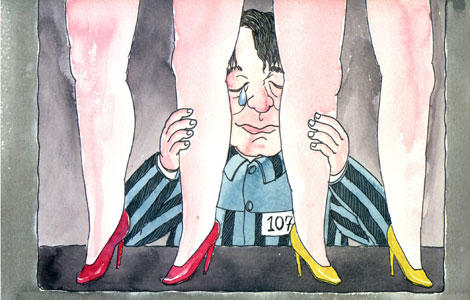Debt crisis not a possibility
Updated: 2013-07-20 07:22
(China Daily)
|
|||||||||||
China Forum | Liu Qiao
But China has to divert flow of money to high-returns sectors of the real economy to ensure continuous economic growth
Is China over-flush with money? This perhaps is one of the most controversial financial topics today.
Since the government announced a 4-trillion-yuan ($651.35 billion) stimulus package in 2008, liquid assets have been rapidly expanding in China - its money stock reached 200 percent of GDP at the end of 2012. In other words, China's money supply has surpassed that of the US, though its real economy is only half the size of the US.
Ironically, China's real economy is still thirsty for money. The "money drain" that has taken place over the past several weeks reflects the fragility of the real economy when liquidity is tightened.
The explanation to this seeming dilemma lies in the structural problems of China's financial system and the real economy. For a long time, China has been relying mainly on investment for economic growth. As a result, whether investment can have a higher return is key to the economic growth.
According to CEIC Data, an international database for emerging and developed markets, China's investment kept increasing for several years and reached 48 percent of GDP in 2011; the figure from the National Bureau of Statistics is even higher. That is not only more than twice the world average of 20 percent, but also higher than that of Japan and the Republic of Korea during their economic rise. It cannot remain so high forever, and China needs to forego its reliance on lower financial risks for growth.
China could, for instance, increase the return of investment capital to maintain a relatively high growth rate. In more popular terms, China needs to shift its economic growth from extensive mode to efficient mode through structural adjustment.
There are two prerequisites to realizing the job. First, the financial system must be able to properly allocate investment to sectors with high returns. And second, investors must be rational enough to find the sectors with high returns and put their money in them.
The problem is, neither prerequisite exists in today's China. Thanks to the government's restrained financial policy, China's financial system has become famous for its low efficiency and narrow service coverage, making it incapable of allocating money to sectors with high returns.
Worse, a large part of the investment with low-repaying cost is controlled by State-owned enterprises and local governments. A combination of data for the past decade shows that the average return rate of surveyed SOEs was below 6 percent, the lowest among all sectors.
Too much easy money is invested in projects with low return rates. This will create debts instead of making profits in the real economy, and thus require more investment to fill the hole.
A vicious circle is formed in the process: the more investment is put in sectors with low returns to replace the debts, the more debt is created in the process.
That's why the real economy faces a money drain even when total social investment is staggering - the money rarely reaches the hands that need it and can make more out of it. A tight monetary policy, which many economists have proposed, cannot solve the problem. Only proper structural adjustments can finish the job.
The advice of many economists to tighten the monetary policy is also based on their worry about a possible debt crisis, but actually the Chinese government's debt accounts for just 50 to 90 percent of GDP, much lower than the 270 percent in the US, more than 300 percent in the European Union and 550 percent in Japan. So as long as the Chinese economy continues to grow, the danger of a debt crisis is not as high as imagined.
Given these deficiencies, it is not advisable for the government to only introduce a tight monetary policy. China's economic growth is not without problems, and its structure needs to be adjusted. But if China uses a tight monetary policy as the sole means of structural adjustment, it is highly likely to face an economic slowdown and encounter more serious problems.
Therefore, if China tightens the monetary policy, it needs to introduce some other measures, too, such as lowering the threshold of the financial market, allowing private capital to enter the economy and, most importantly, changing the role of local governments from decision makers to service providers. Of course, that is not the job of finance authorities alone and requires the determination of higher decision makers.
The author is a professor of finance at the Guanghua School of Management, Peking University. This is an excerpt from his speech at a recent meeting on the economy in the first half of 2013.
Related Stories
A new start and a chance to cleanse debt 2013-07-20 07:22
Local government debt must be properly supervised 2013-07-15 20:49
Local govt debt information is 'opaque' 2013-07-09 14:18
Intense focus on debt 2013-07-05 07:21
Massive debt plagues local gov't 2013-07-01 08:02
Today's Top News
UK, Ireland join forces to lure more Chinese visitors
Chinese police question employee of AstraZeneca
Quake in NW China kills 89, injures 700
Kate gives birth to a baby boy
New visas to boost family reunions
Huawei launches mobile app contest in EU
China to implement stricter air quality controls
China's FX purchases decline
Hot Topics
Lunar probe , China growth forecasts, Emission rules get tougher, China seen through 'colored lens', International board,
Editor's Picks

|

|

|

|

|

|





